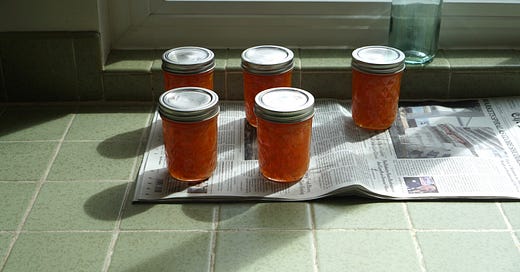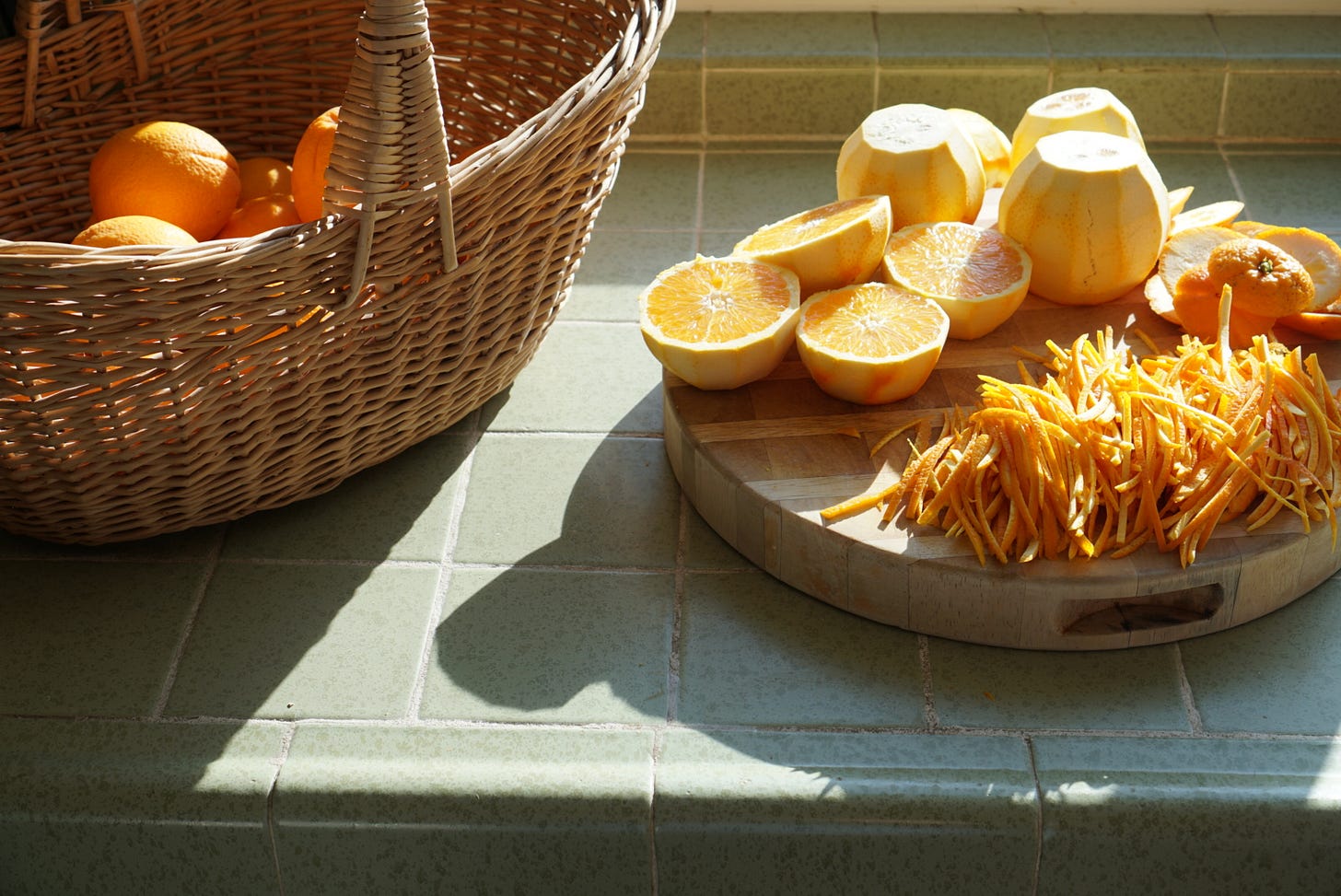Welcome to mama eats, a twice-weekly newsletter inspired by a simple + seasonal home life. This week’s post, a recipe for marmalade, is free to all readers, barring the video of me making it which is viewable by paid subscribers. I try to provide as much free content as possible, however, this newsletter is a labor of love and I am a busy mother of three. If you have the means and find value in what I share, please consider becoming a paid subscriber, which also gives you the benefit of access to the growing archive (posts over a month old).
note: this post is a reprint of an original post of mine from March 2020, with some edits to the recipe, and a video (added at the very end; for paid subscribers) from cooking this year’s batch (2024) for (hopefully helpful) visual cues.
Citrus season here is long and bountiful. We are at the tail end of it now, but still as we walk around town I see the dark green trees heavy with their orbs of scarlet orange. I always associate marmellata with my grandmother. At our house growing up, we never really had marmalade, I’m not sure why, maybe my mom just didn’t prefer it. The rarity made it even more enticing, exotic even. My grandmother would spread it thickly over buttered toast, the translucent orange half moons of the rind glistening like jewels. Along with a cup of milky tea, it made a perfect winter treat.
They had 2 orange trees, a Valencia for the summer and a navel for the winter, which meant lots of marmalade. In her opinion, though, real marmalade should be made with bitter Seville oranges. Lamented was the fact that at the state capitol, one city over from us, there were many Seville trees, boughs thick with fragrant clusters of oranges. Perfect, except that people are prohibited from picking the trees. Forbidden fruit, a personal garden of Eden with arance amare, bitter oranges. “No matter,” I always thought as a kid, regular orange marmalade being delicious all the same, bitter oranges be damned. A mental note was formed though, filed away really, so that when I came across a basket piled high with the elusive Sevilles a few weeks ago, I thought, felt compulsed, really, to make marmalade.
Having never made marmalade myself before, this was a bold undertaking. I had made jam before, but how does one make marmalade, I wondered. You can’t just throw the oranges and sugar into a pot and boil away, like you do with other fruit jams. I asked my gram, and she told me how she did it, how a friend did it, and if I should want to use pectin, how the pectin packet recommended you do it. I knew I didn’t want to use pectin, having rather regretted the grainier texture results with past jams of my repertoire. In the end, I turned to an old and torn cookbook, the page splattered a bit so you know it must be good, or at least have been made and used and loved. After the first batch, I became somewhat singular-minded, greedy, and put up 2 more batches to ensure a longer supply. These subsequent batches were with oranges from our own navel orange tree. The Seville orange marmalade is, unsurprisingly, much more bitter with less of a bright orange flavor. I like both kinds, and it coincidentally was a wonderful time to make jam, as by then the COVID-19 isolation restrictions were in place, and what better to do with time than create. Something to enjoy now, and also later.
As it turns out there’s really not much more to marmalade than making jam, except that you cut the peel into strips, thick or thin, however you like it, then let sit overnight with the juices, some water, and all the odd bits (pith, seeds, pulp) in a muslin bag, tied to the side of the pot. In the morning, you boil, then simmer, this mixture to soften the peel and flavor the water, while your house fills with the bright scent of oranges. Squeeze the pouch to extract all the pectin rich juices, then discard. Add sugar and boil down, stirring often, till a small spoonful of the jam on a saucer that’s been in the freezer makes a blob like the Red Sea- that is, when you push your finger through it, the jam stays on one side and leaves a path through the middle intact. Ladle into clean, warm jars, screw lids on, and process 10 minutes in a boiling water canner for a long term seal. If you’re like me, save one jar out to eat immediately, on toast. Admire the rest of the jars shining their jewel tones on your pantry shelf, and be comforted. Whatever comes, there will be jam.





